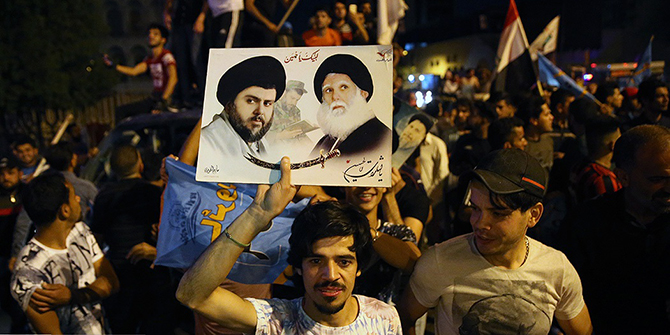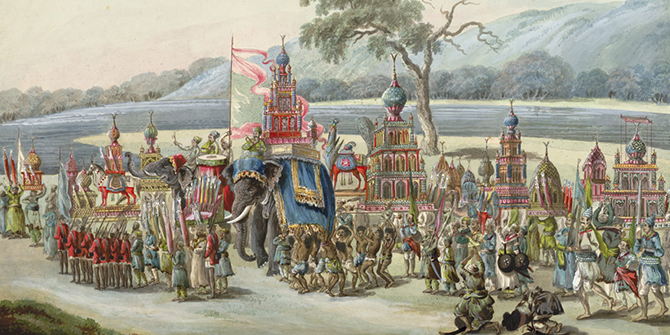by Wladimir van Wilgenburg
#Rojavaat4
This memo was presented at a workshop organised by the LSE Middle East Centre examining the experiment in Western Kurdistan. A report providing a distillation of the presentations and discussions is available to download here.

The YPG (Kurdish People’s Protection Units) is the most effective force on the ground in Syria fighting IS (Islamic State). Its success against IS means that the ‘caliphate’ is now slowly collapsing. Despite the huge role the YPG plays, little is known about the structure and capabilities of the group that in 2012 captured most Kurdish territories in northern Syria.
The YPG managed to gain support from the US-led coalition against IS during its defence of the Kurdish town of Kobane in 2014–2015. Since the Kobane siege, Syrian Kurds have gained further sympathy and support from the West as one of the few groups willing and able to defeat IS.
Unlike the Syrian Arab rebels, the YPG is not willing to work with Islamist actors that are backed by Sunni states in the region. The YPG follows the so-called third line: not backing the opposition nor the Syrian regime, since both reject any form of Kurdish rights. As a result, it clashes both with the regime, but also with Syrian rebels.
Context
The three to four million Syrian Kurds had no experience of armed insurgency in Syria against the Ba’ath regime until the civil war. They lacked a strong independent Syrian Kurdish party and, as a result, were dependent on either the KDP (Kurdistan Democratic Party) that focused on fighting the Iraqi state, or the PKK (Kurdistan Workers Party) that fought Turkey.
As a result, many Syrian Kurds joined the struggle as Peshmerga forces in the 1960s and 1970s in Iraq, or with the PKK against the Turkish state since the 1980s. The Assad regime for a few years granted sanctuary to the PKK in the 1990s until Assad restored its ties with Turkey. The PKK movement’s use of Syrian and Lebanese bases helped it build support among Kurds in Syria. The PKK-affiliated PYD (Democratic Union Party) was set up in Syria in 2003.
Therefore, both the KDP and the PKK had a support base in northern Syria and both started to play a role through their proxies and smaller Kurdish parties when the Syrian Ba’ath regime lost its control over large parts of northern Syria in 2012.
The PKK’s initial idea to form the YPG was initiated in 2004 after the Syrian regime cracked down on the Kurdish uprising that year. YPG self-defence groups were later formed in 2011 and started to organise covertly in Kurdish towns.
First Phase
When the Syrian regime’s national security headquarters in Damascus were bombed on 18 July 2012, killing many important security officials, the PYD/YPG saw an opportunity and, on 19 July, launched what they describe as the ‘Rojava revolution’. They first took control of Kobane since it was a PKK-stronghold with no regime forces present. The town of Afrin was also quickly taken, but the province of Hasakah was more difficult due to the presence of regime forces.
The liberation progressed in three stages: first, targeting the regime in the villages that would act as forward bases for the YPG; second, confiscating service institutions of the regime, such as electricity, water and youth centres; and third, taking over the regime military headquarters, which spread over all provinces except the Kurdish city of Qamishli, where regime forces remain until today.
As a result of dominance on the ground by the YPG, other Syrian Kurdish groups aligned with Massoud Barzani’s KDP were marginalised. Barzani supported the creation of the ‘Rojava Peshmerga’ forces in Iraqi Kurdistan in 2012 that now fight in the Mosul province against ISIS, but the YPG has not allowed them to enter Rojava as it fears a civil war similar to the one fought by the Iraqi Kurds in the 1990s and it does not want competition from the Barzani Kurds.
Second Phase
After the YPG took control of most of the three Kurdish enclaves of Kobane, Afrin, and Jazira (Hasakah), and secured the town of Serekaniye (Ras al-Ayn) in 2013, local self-administrations were set up that were then organised into three separate canton administrations in January 2014. Following this, the main goal of the YPG was to unite these cantons into one contiguous territory in northern Syria.
The YPG also moved towards recruiting non-Kurds and working with local Arab tribes and Christian groups. This resulted, in September 2014, in a joint coordination room with the FSA (Free Syrian Army) in Kobane. Fearing this coordination would receive support from the US, IS besieged Kobane in September 2014, but was defeated there in March 2015. In June 2015, the YPG pushed further and united the cantons of Kobane and Jazira with US support, by capturing Tel Abyad. To advance this move, the YPG created the multi-ethnic SDF (Syrian Democratic Forces) in October 2015.
The YPG’s goal is now to unite all cantons with the SDF, and to set up a federal region in northern Syria and Rojava, within three months. In May 2016, the SDF launched a new operation with US support to take the strategically critical town of Manbij. Whith this operation which was completed on Friday 12 August, the YPG hopes to unite their administrations through Manbij and al-Bab to Afrin.
Concluding Remarks
It seems that Turkey made deals with Iran and Assad to stop the creation of a federal region in northern Syria.
The PKK-linked PYD has managed to gain dominance in northern Syria through the YPG, while KDP-linked parties are marginalised on the ground. The YPG managed to dominate quickly, due to early planning to dominate Rojava, while the Barzani-backed parties were not prepared, and initially supported ‘a peaceful Syrian revolution’. The YPG was formed before the Rojava Peshmergas, and already became the de-facto authority on the ground. It was also more risky for Barzani to get involved in the Syrian civil war, having to protect it’s authority in the Kurdistan region of Iraq.
The SDF forces just defeated IS in Manbij, but the question is whether the US-led coalition will allow the SDF to march on further towards Afrin, or if they will push them to focus on Raqqah, where the Kurds are reluctant to go towards. Moreover, Turkey’s intervention in the town of Jarabulus last Wednesday aims at preventing the unification of the local self-administrations in northern Syria. It seems that Turkey made deals with Iran and Assad to stop the creation of a federal region in northern Syria and backed Syrian rebels to take Jarabulus. This could create more challenges for the YPG. Nevertheless, it is clear that the SDF will remain a crucial Western partner, as long as the IS threat remains in Syria.
As part of the Middle East Centre’s tenth anniversary celebrations in 2020, Wladimir revisited this piece – read his reflections here.
Other Contributions
- The Importance of Rojava–North Syria for the PKK
Cengiz Gunes
- Are the old Syrian Kurdish parties relevant anymore?
Harriet Allsopp
- How does Turkey solve a problem like Rojava?
Zeynep Kaya







4 Comments